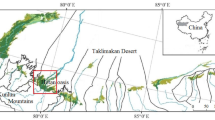Abstract
The stability of oases is one of the key scientific issues in the process of evolution and management of oases in arid areas. The stability of oases and its representation are also different at different scales. This paper deals with the stability of oases at the landscape patch scale with a case study in the Sangong River Watershed of Tianshan Mountains. We employed the remote sensing, geographic information system and mathematical statistical methods to process the remote sensing images of three periods in 1978, 1987 and 1998, and put forward the approaches for representing the oasis stability at the landscape patch scale. The landscape control capacity of oasis patches is a kind of natural driving forces of the dynamic landscape change. The control capacity of a certain patch type on landscape change increases with its area and shape complexity and contrasts between it and other patches, and reduces with its spatial distances between it and other patches. The patch type with the strongest control capacity should be the matrix of landscape. The conversion of oasis landscape patches results from both natural and anthropogenic driving forces, particularly the anthropogenic driving forces. The higher the conversion proportion is, the lower the stability of patch types is and the stronger the anthropogenic disturbance is. The patch type with the strongest net control capacity in the Sangong River Watershed in 1987 was the desert grassland, which was the matrix of landscapes; but the matrix of landscapes had been changed into the irrigated lands in 1987 and 1998. The control capacities of landscape patches on the oasis landscape evolution have gradually reduced with time in the Sangong River Watershed, and the change extents also have reduced gradually. This reveals that the interaction among the landscape patch types generally tends to reduce, and the natural stability of the oasis landscape patches generally tends to increase. However, the conversion among the landscape patches occurs more frequently due to the increase of intensive human activities, which probably causes the lower stability of environmental resources patch and higher stability of introduced patches in the oasis landscape.
Similar content being viewed by others
References
Jia B. Discussion on some theoretical problems of the oasis landscapes. Arid Land Georaphy (in Chinese), 1996, 19(3): 58–65
Jia B, Ci L, Han D L, et al. Review and problem analysis of the research on the oases in arid areas. Earth Science Progress (in Chinese), 2000, 15(4): 381–388
Han D. Elementary study of oasis stability. Journal of Ningxia University (Natural Science Edition) (in Chinese), 1999, 20(2): 136–139
Wang Z, Wang H, Lei Z. Stability analysis of oasis in arid region. Shuili Xuebao (in Chinese) 2002, 33(5): 26–30
Luo G, Chen X, Zhou K, et al. Temporal and spatial variation and the stability of the oasis in the Sangong River Watershed, Xinjiang, China. Sci China Ser D-Earth Sci, 2003, 46(1): 62–73
Luo G, Zhou C, Chen X, et al. Evaluation of the stability of the oasis at the regional scale. Journal of Natural Resources (in Chinese), 2004, 19(4): 519–524
Luo G, Zhou C, Chen X. Preliminary analysis on the oasis stability at the landscape level in the arid region. Arid Land Geography (in Chinese), 2004, 27(4): 471–476
State Bureau of Land Administration of China. Working Rules of the Overall Planning of Land at County-Level (Trial implementation) (in Chinese). 1997, 26–30
Fu B, Chen L, Ma K, et al. Landscape Ecology Theory and Application (in Chinese). Beijing: Science Press, 2002. 5–6
Fu B, Chen L, Ma K, et al. Landscape Ecology Theory and Application (in Chinese). Beijing: Science Press, 2002. 48–49
Fu B, Chen L, Ma K, et al. Landscape Ecology Theory and Application (in Chinese). Beijing: Science Press, 2002. 52–53
Rempel R, Carr A. Patch Analyst extension for Arc View: version 3. http://flash.lakeheadu.ca/:_rrempel/patch/index.html. 2003
Forman R, Godron M. Landscape Ecology. New York: John Wiley & Sons, 1986
Luo G, Zhou C, Chen X. Human-induced spatio-temporal changes of oasis through landscape pattern analysis: A case study of oasis in the Sangong River. Acta Ecologica Sinica (in Chinese), 2005, 25(9): 2197–2205
Author information
Authors and Affiliations
Corresponding author
About this article
Cite this article
Luo, G., Zhou, C. & Chen, X. Stability of patches of oasis landscape in arid areas: A case study of Sangong River Watershed, Xinjiang, China. CHINESE SCI BULL 51 (Suppl 1), 92–100 (2006). https://doi.org/10.1007/s11434-006-8212-1
Received:
Accepted:
Issue Date:
DOI: https://doi.org/10.1007/s11434-006-8212-1




